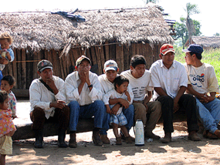


Indigenous peoples in Paraguay, or Native Paraguayans, include 17 ethnic groups belonging to five language families.[1][2] While only a 1.7% of Paraguay's population is fully indigenous, 75% of the population identifies as being partially of indigenous descent;[3] however, the majority do not identify as being indigenous but as Mestizos. Most of the native population lives in the northwestern part of the country, the Gran Chaco.
YouTube Encyclopedic
-
1/4Views:1 857 5619 0266 9641 502
-
Paraguayans: The World's Weirdest Latinos
-
The Guaraní People - South America - History, Culture & Associations
-
Fighting just to be home: Ayoreo Indigenous People | SLICE
-
Manjui people of Paraguay receive the Bible after 40 years of mission work.
Transcription
Population
The Second National Indigenous Census, conducted in 2002, recording approximately 87,099 people, or 1.7% of the country's population, as being indigenous;[1] however, as many as 75% of the Paraguayan population is mestizo, that is of partial Amerindian descent.[3] Since the late 20th century, the indigenous population is growing faster than the rest of the population. As of 2002, 47.1% of the native population was 14 years old or younger.[1]
Settlement

An increasing percentage of the registered indigenous population lives in the northwestern region of Paraguay. The 1981 census reported 32.8% of the indigenous peoples living there, while 44.2% lived there in 1992, and 50.7% in 2002. The majority of indigenous peoples live in rural areas in 412 indigenous communities.[1]
Indigenous reserves are in place to protected uncontacted peoples and other isolated communities.[4]
Languages
Indigenous Paraguayan languages belong to five language families: Guarani, Guaycuru, Maskoy, Mataco-Mataguayo, and Zamuco.[1] The Guarani language, along with Spanish, is an official language of Paraguay and is spoken by 90% of the population.
Social issues
Literacy rates are low among indigenous peoples in Paraguay, who have an illiteracy rate of 51% compared to the 7.1% rate of the general population.[1]
Access to clean drinking water is a major challenge. Only 2.5% of Paraguay's indigenous population has access to drinking water and only 9.5% have electricity.[1]
Tribes
See also
Notes
- ^ a b c d e f g "Paraguay." Pan-American Health Organization. (retrieved 12 July 2011)
- ^ a b c d e "Paraguay." Countries and Their Cultures. (retrieved 12 July 2011)
- ^ a b "Paraguay: Ethnic Groups." CIA: The World Factbook. (retrieved 12 July 2011)
- ^ Dimitri Selibas (5 July 2023). "Bill stripping Peru's isolated Indigenous people of land and protections scrapped". Mongabay. Retrieved 7 July 2023.
- ^ a b c d e f g h i j k "Native American Tribes of Paraguay." Native Languages. (retrieved 12 July 2011)
External links
- Instituto Paraguayo del Indigena (in Spanish)
- "Paraguay's Indigenous Peoples in Peril", Amnesty International
- Assessment for Indigenous Peoples in Paraguay
- Indigenous Squatter Communities Organise Self-Help, InterPress Service Agency

